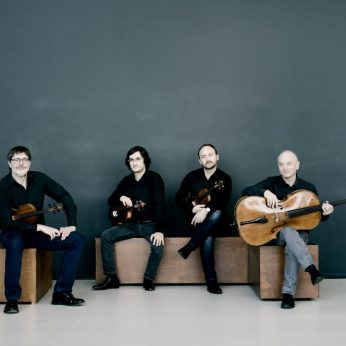Composer: Mieczyslaw Weinberg (b. 1919 - d. 1996)
Performance date: 28/06/2022
Venue: St. Brendan’s Church
Composition Year: 1945
Duration: 00:21:39
Recording Engineer: Simon Cullen, Ergodos
Instrumentation: 2vn, va, vc
Instrumentation Category:String Quartet
Artists:
Quatuor Danel (Marc Danel, Gilles Millet [violins], Vlad Bogdanas [viola], Yovan Markovitch [cello] -
[quartet]

Mieczysław Weinberg [1919-1996]
Quartet No.5 in B flat major Op.27 [1945]
1 .Melodia – Andante sostenuto
2. Humoreska – Andantino
3. Scherzo – Allegro molto
4. Improvisation – Lento
5. Serenata – Moderato con moto
Weinberg is inevitably compared with Shostakovich for the two became close friends and their music trod similar paths with a clear two-way exchange of ideas. Shostakovich tends to go for the knock-out blow, those devastating scherzos and the almost unbearable slow movements, while Weinberg, especially in this wonderful Quartet, creates similar effects with more subtlety, even delicacy. They both however shared an anarchic sense of humour.
This is the third of Weinberg’s War Quartets. After the power play of the Fourth Quartet he seemingly reduces his forces with a sparseness of texture, most obvious in the opening movement which begins with the unaccompanied first violin announcing a wisp of theme, the score spare and unadorned, only gradually is its sadness made unambiguous as the music expands. The end returns to the beginning. The Humoreska is opened by a simple melody with a pizzicato accompaniment that is gradually developed and explored, its folk-like tune changing its skin for something darker and deeper before working edgily back towards the earlier simplicity and a highly ambiguous coda.
The Scherzo is a mini tornado, played at outrageous speed and gone in a flash. The solo first violin leads the way through the muted colours of the fourth movement, a quiet, gentle movement to atone for the outspoken Scherzo. The final movement opens deceptively with a lover serenading at the window of the beloved and once again the seeming simplicity of a love-song is overwhelmed by outside forces, leading to the most terrifying outburst in the entire work. Nothing is as it seems and darkness awaits us all, there’s a voice singing in the wilderness, internal disintegration and slow collapse, the final cadence is breathtaking.
Francis Humphrys
Copyright © 2024 West Cork Music. All rights reserved.
Designed and developed by Matrix Internet